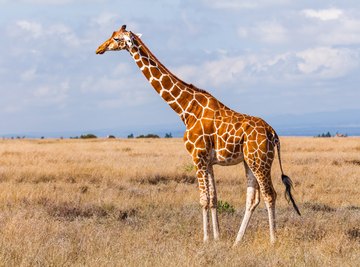
Behavioral adaptations help organisms survive and reproduce in nonindigenous and dangerous environments. Behavioral adaptations take time to develop as they are genetically passed on to ensuing generations. Giraffes have developed several behavioral adaptations because of their physical characteristics and environmental demands. The following are commonly recognized behavioral adaptations of giraffes by zoologists and wildlife observers.
Drinking water
Mammals must drink water in order to survive, but drinking water can be very dangerous for a giraffe. A giraffe’s main predators are humans, hyenas, lions and crocodiles. Giraffes have very long necks; bending down to drink water makes giraffes susceptible to attack because they cannot see what is going on around them. Animal predators can quickly grab the giraffe’s neck to crush it, and human poachers can get a better aim. A behavioral adaptation giraffes make when they drink water is to gulp it. Gulping is drinking a lot of liquid quickly without choking. Giraffes gulp as much as 10 gallons of water in a few minutes. They have also adapted the ability to go a long time without drinking a lot of water. Giraffes can survive off the water from the morning dew and water content on tree leaves.
Sleeping
A giraffe’s height and weight become cumbersome when it is time to go to sleep; adult male giraffes get as tall as 19 feet and weigh as much as 3,000 lbs., and adult female giraffes grow as tall as 16 feet and weigh up to 2,400 lbs. Lying down to go to sleep presents a problem if a giraffe has to get up quickly to run from an approaching predator. So giraffes have adapted the ability to sleep standing up. Also, giraffes can survive with 30 minutes of sleep a day. Usually giraffes sleep in five-minute intervals, while another giraffe is watching for danger.
Eating habits
Giraffes spend up to 18 hours a day feeding on grass, shrubs and other foliage. During droughts, giraffes restrict their eating pattern and survive without food because they survive off the stored food in one of their four stomach chambers. The giraffe also adapts its diet to eat the foliage of the acacia tree. The tree has very sharp thorns and other animal herbivores avoid eating its foliage; but, the giraffe produces thick saliva that coats its mouth and helps to digest the foliage and thorns. The giraffe also uses its long tongue to reach around the thorny spikes to pluck the foliage off the tree.
Social adaptation
A giraffe extends its long neck to sleep, reach food, look out for danger and for male giraffes to establish dominance during mating. But half the time giraffes use their necks to graze on plants and leaves below their shoulder level. Physically, giraffes are quiet, extremely tall, have excellent eyesight and are considered very intelligent. The intelligence of giraffes is a factor in how quickly they adapt behaviorally in response to changing external stimuli.
